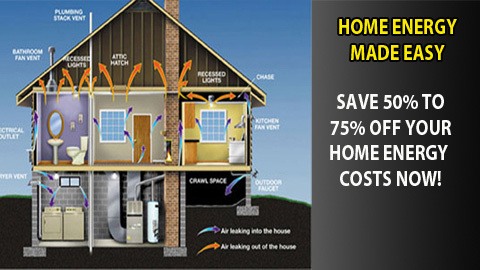Click Video to Watch
Water Heating Systems
The most important thing you need to take away from this lesson is…
Sooner or later you’ll have to replace your hot water heater. Understanding your water heating system now can result in HUGE energy saving in the future. You may also want to consider replacing your current hot water heating device with a solar model and get your hot water for free. This lesson will lay the ground work for your decision.

Overview of Hot water heaters, and different systems
You use hot water for a number of different things during the course of the day. Understanding where your hot water is going is the first step in preparing a system to handle the job.

The lowest-priced storage water heater may be the most expensive to operate and maintain over its lifetime. While an oversized unit may be alluring, it carries a higher purchase price and increased energy costs due to higher standby energy losses.
Before buying a new storage water heater, you need to consider the following:
Selecting a Storage Water Heater
Sizing Storage and Heat Pump (with Tank) Water Heaters
To properly size a storage water heater—including a heat pump water heater with a tank— for your home, use the water heater's first hour rating (FHR).

The first hour rating is the amount of hot water in gallons the heater can supply per hour (starting with a tank full of hot water). It depends on the tank capacity, source of heat (burner or element), and the size of the burner or element.
Do the following to estimate your peak hour demand:

- Determine what time of day (morning, noon, evening) you use the most hot water in your home. Keep in mind the number of people living in your home.
Use the worksheet in the .pdf to estimate your maximum usage of hot water during this one hour of the day—this is your peak hour demand. Note: the worksheet does not estimate total daily hot water usage.
The worksheet example shows a total peak hour demand of 46 gallons. Therefore, this household would need a water heater model with a first hour rating of 44 to 48 gallons.
Conventional Storage Water Heating Units
Conventional storage water heaters remain the most popular type of water heating system for the home. Here you'll find basic information about how storage water heaters work; what criteria to use when selecting the right model; and some installation, maintenance, and safety tips.
How They Work

A single-family storage water heater offers a ready reservoir—from 20 to 80 gallons—of hot water. It operates by releasing hot water from the top of the tank when you turn on the hot water tap.
To replace that hot water, cold water enters the bottom of the tank, ensuring that the tank is always full.
Conventional storage water heater fuel sources include natural gas, propane, fuel oil, and electricity.
Natural gas and propane water heaters basically operate the same. A gas burner under the tank heats the water. A thermostat opens the gas valve as the water temperature falls.
The valve closes when the temperature rises to the thermostat's set point. Oil-fired water heaters operate similarly, but they have power burners that mix oil and air in a vaporizing mist, ignited by an electric spark. Electric water heaters have one or two electric elements, each with its own thermostat.
With two electric elements, a standby element at the bottom of the tank maintains the minimum thermostat setting while the upper demand element provides hot water recovery when demand heightens.
Demand (Tank less or Instantaneous) Water Heating Devices
Demand (tank less or instantaneous) water heaters provide hot water only as it is needed. They don't produce the standby energy losses associated with storage water heaters, which can save you money. Here you'll find basic information about how they work, whether a demand water heater might be right for your home, and what criteria to use when selecting the right model.
How They Work

Demand water heaters heat water directly without the use of a storage tank. Therefore, they avoid the standby heat losses associated with storage water heaters.
When a hot water tap is turned on, cold water travels through a pipe into the unit. Either a gas burner or an electric element heats the water. As a result, demand water heaters deliver a constant supply of hot water.
You don't need to wait for a storage tank to fill up with enough hot water. However, a demand water heater's output limits the flow rate.
Typically, demand water heaters provide hot water at a rate of 2–5 gallons (7.6–15.2 liters) per minute. Gas-fired demand water heaters produce higher flow rates than electric ones.
Sometimes, however, even the largest, gas-fired model cannot supply enough hot water for simultaneous, multiple uses in large households. For example, taking a shower and running the dishwasher at the same time can stretch a demand water heater to its limit.
To overcome this problem, you can install two or more demand water heaters, connected in parallel for simultaneous demands of hot water. You can also install separate demand water heaters for appliances—such as a clothes washer or dishwater—that use a lot of hot water in your home.
Other applications for demand water heaters include the following:
- Remote bathrooms or hot tubs
- Booster for appliances, such as dishwashers or clothes washers
- Booster for a solar water heating system.
For homes that use 41 gallons or less of hot water daily, demand water heaters can be 24%–34% more energy efficient than conventional storage tank water heaters. They can be 8%–14% more energy efficient for homes that use a lot of hot water—around 86 gallons per day. You can achieve even greater energy savings of 27%–50% if you install a demand water heater at each hot water outlet.
Selecting a Demand Water Heating Device
Demand water heaters cost more than conventional storage water heaters. However, you may find that a demand water heater may have lower operating and energy costs, which could offset its higher purchase price.
Tank less Coil and Indirect Water Heating Units

Tankless coil and indirect water heaters use a home's space heating system to heat water. They're part of what's called integrated or combination water and space heating systems.
How They Work
A tank less coil water heater uses a heating coil or heat exchanger installed in a main furnace or boiler. Whenever a hot water faucet is turned on, the water flows through the heat exchanger.
These water heaters provide hot water on demand without a tank, like a demand water heater, but because they rely on the furnace or boiler to heat the water directly, tank less coil water heaters work most efficiently during cold months when the heating system is used regularly. That's why they can be an inefficient choice for many homes, especially for those in warmer climates.

Indirect Water Heating Units
Indirect water heaters offer a more efficient choice for most homes, even though they require a storage tank. An indirect water heater uses the main furnace or boiler to heat a fluid that's circulated through a heat exchanger in the storage tank.
The energy stored by the water tank allows the furnace to turn off and on less often, which saves energy. Therefore, an indirect water heater is used with a high-efficiency boiler and well-insulated tank can be the least expensive means of providing hot water.
Indirect systems can be fired by gas, oil, propane, electric, solar energy, or a combination of any of these. Tankless systems are typically electric or gas-fired. Also, these integrated or combination water heating systems not only can work with forced air systems but also with hydronic or radiant floor heating systems.
Selecting a Combination Water and Space Heating System
Integrated or combination water and space heating systems usually cost more than a separate water heater and furnace or boiler, but installation and maintenance costs may be less. For example, you won't need multiple utility hook-ups since there's one source of heat. There also aren't as many moving parts to maintain or service. Some of these high efficiency systems may also provide you with lower utility costs.
Most combination water and space heating systems are usually designed for new construction. However, there are some retrofit units available that can work with an existing water heater.
When selecting a system, you need to consider its size. The sizing of a combination system involves some different calculations than those used for sizing a separate water heating or space heating system. It's best left to a qualified plumbing and heating contractor.
Downloads/Resources (Click to view or right click to download)
Checklists, Cheat sheets,...

Solar Hot Water Collector: The Best Guide to Building and Installing a Solar Hot Water System
Hello there, fellow solar enthusiasts! It’s great to be talking with you

Hybrid Solar Wind Power Generation System: Best Comprehensive Guide to Building Your Own Renewable Energy Solution
Hello there! If you are looking for an alternative energy source that

Solar Heating System: Best Comprehensive Guide to Building and Installing a Solar Heating System
As a solar heating system expert, I have seen firsthand how this

Solar Cooling: How to Keep Your Home Cool with Solar Energy?
Hey there, folks! As a solar cooling consultant with years of experience

Stand Alone Solar Power System: How to Build an Off-Grid Solar Power System for Your Home?
As the demand for sustainable energy solutions increases, stand alone solar power

Solar Heating Systems: The Different Types and Benefits Of Solar Heating Systems
As a solar heating systems expert, I know that these innovative technologies

